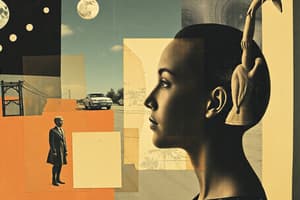Podcast
Questions and Answers
What is the primary difference between sensation and perception?
What is the primary difference between sensation and perception?
Sensation involves the detection of physical stimuli, while perception is how the brain organizes and interprets these stimuli to create meaningful experiences.
Describe the process of transduction in sensory systems.
Describe the process of transduction in sensory systems.
Transduction is the conversion of physical energy, such as light or sound waves, into neural signals that the brain can interpret.
List the six senses and briefly describe the function of each.
List the six senses and briefly describe the function of each.
The six senses are vision (detects light), hearing (detects sound), touch (detects pressure), taste (detects flavors), smell (detects odors), and proprioception (senses body position).
What role do sensory receptors play in sensation?
What role do sensory receptors play in sensation?
Explain sensory adaptation with an example.
Explain sensory adaptation with an example.
How do the olfactory bulbs interact with the brain's limbic system?
How do the olfactory bulbs interact with the brain's limbic system?
What is nociception and its significance in the sensory process?
What is nociception and its significance in the sensory process?
Define reflexes and provide an example.
Define reflexes and provide an example.
What are the three main processes involved in memory?
What are the three main processes involved in memory?
Define the difference between declarative and non-declarative memory.
Define the difference between declarative and non-declarative memory.
List the five traits of the Big Five Personality model.
List the five traits of the Big Five Personality model.
In Freud's psychodynamic theory, what are the three components of the psyche according to the Iceberg Model?
In Freud's psychodynamic theory, what are the three components of the psyche according to the Iceberg Model?
What does Maslow's Hierarchy of Needs illustrate?
What does Maslow's Hierarchy of Needs illustrate?
Identify the three main types of mental health disorders classified in the DSM-V.
Identify the three main types of mental health disorders classified in the DSM-V.
What is the primary goal of humanistic therapy?
What is the primary goal of humanistic therapy?
What is family therapy primarily focused on?
What is family therapy primarily focused on?
What distinguishes instincts from learned behaviors?
What distinguishes instincts from learned behaviors?
Describe the main difference between associative and non-associative learning.
Describe the main difference between associative and non-associative learning.
What was the main outcome of Pavlov's classical conditioning experiment?
What was the main outcome of Pavlov's classical conditioning experiment?
Explain the difference between reinforcement and punishment in operant conditioning.
Explain the difference between reinforcement and punishment in operant conditioning.
What are the cognitive processes key to observational learning according to Bandura?
What are the cognitive processes key to observational learning according to Bandura?
Differentiate between emotions and moods.
Differentiate between emotions and moods.
List the primary emotions identified by Ekman.
List the primary emotions identified by Ekman.
What role does the amygdala play in emotional processing?
What role does the amygdala play in emotional processing?
Flashcards
Sensation vs. Perception
Sensation vs. Perception
Sensation is detecting physical stimuli (light, sound) with sensory organs; perception is the brain's interpretation of these stimuli to form meaningful experiences.
Sensory Transduction
Sensory Transduction
Converting physical energy (e.g., light, sound) into neural signals the brain can understand.
Sensory Adaptation
Sensory Adaptation
Sensory receptors become less responsive to persistent stimuli.
Vision
Vision
Signup and view all the flashcards
Olfactory System
Olfactory System
Signup and view all the flashcards
Proprioception
Proprioception
Signup and view all the flashcards
Reflex
Reflex
Signup and view all the flashcards
Sensory Receptors
Sensory Receptors
Signup and view all the flashcards
Encoding
Encoding
Signup and view all the flashcards
Working Memory
Working Memory
Signup and view all the flashcards
Declarative Memory
Declarative Memory
Signup and view all the flashcards
Big Five Traits
Big Five Traits
Signup and view all the flashcards
Id (Freud)
Id (Freud)
Signup and view all the flashcards
Defense Mechanisms
Defense Mechanisms
Signup and view all the flashcards
Maslow's Hierarchy
Maslow's Hierarchy
Signup and view all the flashcards
Family Therapy
Family Therapy
Signup and view all the flashcards
Instinct
Instinct
Signup and view all the flashcards
Learned Behavior
Learned Behavior
Signup and view all the flashcards
Associative Learning
Associative Learning
Signup and view all the flashcards
Classical Conditioning
Classical Conditioning
Signup and view all the flashcards
Operant Conditioning
Operant Conditioning
Signup and view all the flashcards
Primary Emotions
Primary Emotions
Signup and view all the flashcards
Amygdala
Amygdala
Signup and view all the flashcards
Emotion vs. Mood
Emotion vs. Mood
Signup and view all the flashcards
Study Notes
Sensation vs. Perception
- Sensation is the detection of physical stimuli (like light or sound) by sensory organs.
- Perception is the brain's organization and interpretation of sensory input, creating meaningful experiences.
The Sensory Processes
- Detection: Sensory organs interacting with stimuli in the environment.
- Transduction: Converting physical energy (light, sound, etc.) to neural signals.
- Transmission: Sensory neurons sending neural signals to the brain for processing.
Sensory Systems
- Vision: Eyes detect light, color, and movement.
- Hearing (Auditory): Ears detect sound waves.
- Touch (Tactile): Skin receptors detect pressure, temperature, and pain.
- Taste (Gustatory): Taste buds on the tongue detect different tastes (sweet, salty, sour, bitter, umami).
- Smell (Olfactory): Nose detects odors through olfactory receptors.
- Proprioception: Sensing body position and balance through receptors in muscles and joints.
Sensory Receptors and Neurons
- Specialized cells detect specific stimuli and convert them into neural signals.
Sensory Adaptation
- Receptors become less sensitive to constant stimuli.
Reflexes and Instincts
- Reflexes are automatic responses to stimuli (e.g., blinking).
- Instincts are complex inborn behaviors for survival (e.g., bird migration).
Learned Behaviors
- Learned behaviors are acquired through experience, practice, or observation.
Associative vs. Non-Associative Learning
- Associative Learning: Forming connections between stimuli or behaviors and consequences.
- Non-Associative Learning: Changes in response to a single stimulus (habituation, sensitization).
Classical Conditioning
- Pavlov's Dogs: Associating a neutral stimulus (bell) with food to elicit a conditioned response (salivation).
Operant Conditioning
- Shaping behavior through consequences (reinforcement, punishment).
Observational Learning
- Learning by observing others.
Emotions
- Emotions are complex reactions involving physiological responses, behaviors, and subjective experiences.
- Emotions are temporary and intense; moods are long-lasting and less intense.
- Primary emotions include happiness, sadness, fear, anger, surprise, and disgust.
Brain Regions and Emotions
- Amygdala: Essential for processing emotions, especially fear.
- Thalamus: Relays sensory information to the correct brain regions.
- Hippocampus: Links emotions to memories.
Memory Stages
- Encoding: Converting sensory input into memory.
- Storage: Maintaining memory over time.
- Retrieval: Accessing and using stored information.
Types of Memory
- Sensory Memory: Brief sensory information storage.
- Working Memory: Holds and manipulates information actively.
- Long-Term Memory: Stores information for extended periods.
Declarative vs. Non-Declarative Memory
- Declarative Memory: Explicit memories (facts and experiences).
- Non-Declarative Memory: Implicit memories (skills and conditioned responses).
Personality
- Personality is enduring patterns of thoughts, feelings, and behaviors.
- Big Five Traits: Openness, conscientiousness, extraversion, agreeableness, neuroticism.
Freud's Psychodynamic Theory
- Id, ego, and superego representing different aspects of the psyche.
- Defense mechanisms protect the ego from anxiety.
Humanistic Perspective
- Maslow's Hierarchy of Needs.
- Rogers' emphasis on self-concept and unconditional positive regard.
Psychological Disorders
- DSM-5 provides criteria for diagnosing mental health disorders.
- Anxiety disorders are conditions like GAD, panic attacks, phobias, and OCD.
Psychotherapy
- Various types of therapy exist to address psychological distress.
- examples include family therapy, humanistic therapy, cognitive-behavioral therapy (CBT), and psychodynamic therapy.
Stress and Coping
- Stress is the body's response to challenges.
- General Adaptation Syndrome - body's three stages of response to stress (alarm, resistance, and exhaustion).
- Coping Mechanisms - problem-focused coping and emotion-focused coping.
- Building resilience helps cope with stressors.
Studying That Suits You
Use AI to generate personalized quizzes and flashcards to suit your learning preferences.




